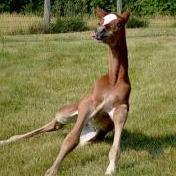-
Posts
1,284 -
Joined
-
Last visited
Content Type
Profiles
Forums
Events
Blogs
Gallery
Everything posted by TomE
-
@Doc Reaper nice work! The lettering is sharp looking. Bet the kid will be proud of it.
-

What size punch or what tool would you use for this?
TomE replied to jcwoman's topic in How Do I Do That?
Like Chuck said, match the hole size to the buckle tongue. The tongue varies with buckle style even among 1/2 inch buckles. For tack, it’s recommended to keep the holes as small as possible to maintain strength of the strap. One trick is to punch the holes from the backside - the side that the tongue inserts into - because the hole will be larger on the side you’re working from. For punching holes I like the Osborne spring punch #153 because the tubes have a gradual taper in comparison to rotary punches with shorter tubes. There is a wide range of tube sizes for the spring punch. -
I use an Osborne 3 lb rawhide mallet (#393-3) for all my drive punches. Well balanced and should last a lifetime, at least the time I have remaining. Second the idea of punching on a stone surface covered with a layer that won't damage the punch. I use a poly clicker board on a piece of granite.
-
I hadn't heard of or seen hay chaps in our area, where most of the small bales are still loaded and stacked by hand. The hay chaps I see online are similar to a farrier's apron without the added layer on the thigh. Would enjoy seeing the chaps you make. Thinking about making a new farrier's apron for myself. I've rasped through the stitching a few too many times and edges are ragged.
-
I'd make a test piece matching the project then try a solvent like Fiebings Deglazer or acetone to see if it dissolves enough wax to allow the pigment to be taken up into the leather. I don't know what your wax or process was. Can you add dye pigment to the wax mixture or re-wax the project after stripping and dyeing? The Fenice Colorfast dye (Campbell Randall) that I use for some tack repairs is a water soluble dye with waxes added.
-
@chuck123wapati is that frame for gathering hay out of the field or loading it on the hay mow? My farm girl-wife will enjoy seeing the pictures tonight.
-
@chuck123wapati is there much hay produced in your area? A long distance trucker in our area brings large square bales of WY and KS hay back here for sale. I buy small bales from local producers bc I can see it growing in the fields and it's easier to handle the small bales. The hilly ground around here is good for pasture and hay fields. Row crops are grown in the MO River bottom. We had a barn with a loft that was built in 1939 and was falling down in the wet Missouri weather. Habitat for Humanity salvaged the tin and the lumber, which they already had buyers for.
-
In defense of Deglazer, it works well to remove excess Barge cement without leaving an oily residue. @firearian, when you say "dyeing my cuts" do you mean the edges of the leather? I usually burnish edges with water before applying dye. I am typically dyeing the edge of bridle leather a darker color and the smooth burnished edge takes the dye in a neater manner than a rough edge.
-
Welcome @fitz101. You're making some handsome leatherwork. Good luck with the machines. I'll be interested in which items you continue to sew by hand.
-
That is totally cool. Don't see much hay put up in lofts in this age of steel pole barns. Did someone take the tin off the roof for another building? Shame to let those rafters rot in the weather.
-
@MtlBiker your artwork is more interesting than mine. I was a scientist making figures for papers and talks on mechanisms of DNA repair. Never learned about color space or profiles, but it would have helped for those times when slides didn't display the way I wanted. Here's a picture of human DNA ligase I, a protein structure we determined by x-ray crystallography, with our cartoon rendering of a chromosome in the background. That's about as fanciful as my work got. I am pretty good at identifying right-handed vs. left-handed helices in the stamped borders of leatherwork.
-
Thanks @MtlBiker! That’s exactly what I needed to know. I will do some reading and put this new knowledge into practice. I appreciate you pointing me in the right direction.
-
Maybe I'm being too picky. Here are the same photos posted on FB https://m.facebook.com/groups/FLeathercrafters/permalink/10160079757549603/?ref=content_filter and on this forum
-
Not sure where to put this. When I upload JPEG photos to this site they display significantly darker with the tones are rather muddy. This is true when viewing the site with different browsers, and this doesn't happen when I upload to other forums and social media. I crop and adjust tone/brightness etc using Photoshop before uploading a JPEG. Is there a different file format or settings that work well for you?
-
Might look at stearic acid added to beeswax as a hardener, and working the hot wax mixture into the pre-warmed leather. I read about this in the current issue of the Leather Crafters and Saddlers Journal. There's an article on "Custom Hardened Leather Arch Supports" by Jason Timmermans, and I see a fair amount online about using stearic acid as a wax hardener.
-

Anyone know what this is called and where to find it?
TomE replied to pdbalestracci's topic in How Do I Do That?
Similar to a halter snap. The clip can be spring steel or a cast piece with the spring in the base. Batz Corp carries quite a few variations in zinc diecast, solid brass, or steel. I find it easier to download their PDF catalog to find part numbers then search the website for the part. https://products.batzusa.com/item/spring-snaps/340z-rigid-square-eye-spring-snap-hooks/340z-1-np -
Awls are no different from other tools that pierce or cut leather. Sooner or later you’ll have to sharpen them. I’m very happy with Osborne awls and hafts. Once I have them shaped and sharpened to my liking it’s not hard to keep them sharp - except when I drop the awl. I use wet/dry abrasive to sharpen and card stock coated with rouge to strop. Learned from a Stohlman book but Nigel Armitage has a video showing the same method.
-

Trying to make a wrangler/rough rider holster.
TomE replied to Frankster's topic in How Do I Do That?
Can’t beat Stohlman for classic leatherwork. Will add the holsters book to my collection. -
Thanks. He's a 4 year old warmblood who started under saddle last fall and is learning his job.
-

Trying to make a wrangler/rough rider holster.
TomE replied to Frankster's topic in How Do I Do That?
Second that - I really like the tooling you've done. Makes me think I need to learn something more than cutting and sewing straps together. Is the artwork your design? -
I thought this was an interesting demonstration, but I don't carve leather and am easily entertained.
-
Lucas Hub Oil is an upgrade IMO from standard 90W gear oil. Sold at Tractor Supply Co and auto parts stores. Not a sewing machine, but it quieted the gear box in my 14 year old rotary cutter (brush hog).
- 28 replies
-
- grease
- industrial sewing machine
-
(and 1 more)
Tagged with:
-
Don't think you'll go wrong with glycerin saddle soap, and you can always add conditioner later if desired. I clean a lot of tack with a bucket of warm water, a sponge, and a bar of saddle soap. Wring out the sponge - you don't need to soak the leather. After applying saddle soap, wipe off the excess using the sponge rinsed in water and wrung out. For tack, I like Bick's 4, Fiebings Aussie, and Blackrock conditioners. The Aussie is less likely to darken the leather than the other two.

.jpg.d60258221c476480a6e073a8805645bb.jpg)

